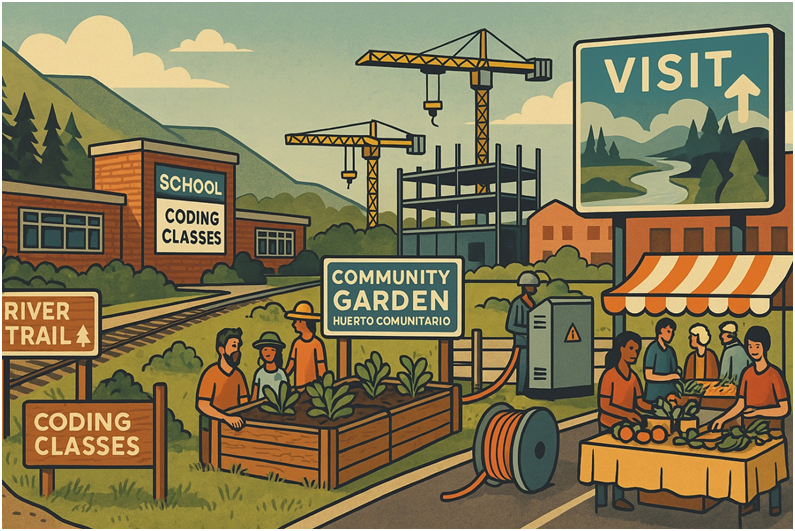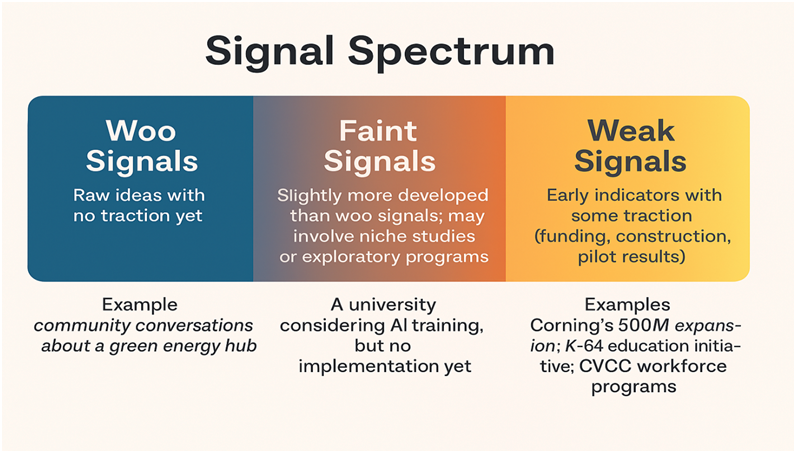The Foothills Corridor - Part II - Chapter 6 - Signals in the Smoke
Understanding Woo, Faint, and Weak Signals
Part II
Signals in the Smoke
Reading the Early Signs of a Region Trying to Rise
If Part I was the autopsy, this next section is the search party.
The collapse of the Foothills Corridor left behind more than just broken buildings and hollowed-out towns—it left a haze. In that haze are signs, sometimes faint, that something is shifting. Not a full comeback. Not a revival you’d put on a billboard. But smoke, curling upward from places most people stopped watching.
These are the early indicators—weak signals and partial awakenings. A new training program in one county. A brewery that’s hiring in another. A fiber-optic line finally laid where dial-up still reigned. They’re easy to overlook, but together, they suggest something bigger: a region trying to remember how to believe in itself again.
This part of the story is about picking up the pieces—not all at once, and not with the funding or fanfare that other regions might get. It's about what happens when ordinary people start to push back against decline, when small victories pile up, and when local leaders stop waiting for outside solutions and start building from the ground up.
It’s not a miracle. It’s a grind. But these signals—however faint—mean that the Foothills Corridor isn’t done. It’s whispering a new narrative. And the question is: Are we ready to listen?
Charter 6
Understanding Woo, Faint, and Weak Signals
Before a region rebuilds, it whispers. It tests the waters with new ideas, small wins, and quiet efforts that often go unnoticed—until someone connects the dots. That’s the story unfolding across the Foothills Corridor. After decades of economic collapse and civic atrophy, the early indicators of change aren’t being shouted from rooftops. They’re murmured in classrooms, backroad boardrooms, broadband blueprints, and pilot programs.
In a region like the Foothills Corridor, recognizing early signals isn’t just strategic—it’s survival.
These are what we call woo, faint, and weak signals—early-stage indicators that something may be stirring beneath the surface. They’re not the big headlines. They’re not yet proven outcomes. But they matter, because every transformation starts somewhere. Some of the most impactful signals in this region started with nothing more than a sticky note and a borrowed room.
Understanding these signal types helps local leaders, residents, and planners better read the landscape and act with clarity instead of guesswork. Here’s how they work—and how to spot them.
Reading the Region: Visual Clues of a Place in Transition
Woo Signals: The Earliest Whispers
Definition: Woo signals are raw ideas with no formal traction. They usually appear as speculative conversations, brainstormed concepts, or hopeful visions. They often sound like, “What if we...?” or “Someone should...”
· Example in the Foothills: A local nonprofit casually discussing a green energy incubator. A city planner dreaming about a youth makerspace. A pastor imagining a coalition of churches buying a shuttered mill to turn into housing.
· Why They Matter: Woo signals may not materialize right away, but they reflect the emerging desires and latent creativity of a community. If enough people begin to voice the same woo signal, it may evolve into something more tangible.
· The Risk: Woo signals can be dismissed too easily as unrealistic. But they often contain the DNA of future breakthroughs.
Faint Signals: Early Flickers of Action
· Definition: Faint signals represent a step up from woo—they’re speculative ideas that have moved into early exploration. They may have a name, a steering group, or a line in a grant application, but they haven’t reached full momentum yet.
· Example in the Foothills: A community college considering a data analytics certificate program, but hasn’t yet enrolled students. A rural town applying for broadband funding for the first time. A regional tourism board floating the idea of a Foothills trail network to connect outdoor economies.
· Why They Matter: Faint signals test feasibility. They attract early partners and create momentum. They represent a community’s attempt to pivot, even when the tools aren’t yet in place.
The Risk with Woo and Faint signals: These signals may fade if not supported. They require patience and belief. Often, the resources come after the vision—not before.
Weak Signals: The First Real Steps
· Definition: Weak signals are concrete but early-stage efforts that have secured some traction—funding, staff, pilot results, or visible infrastructure. They are measurable, repeatable, and worth monitoring.
Examples in the Foothills:
· The Valley Datacenter Academy, created in partnership with Microsoft, training students in high-demand IT roles.
· The Foothills Food Hub, which distributed over 92,000 lbs. of local produce last year and runs a commercial kitchen.
· The City Walk and Riverwalk in Hickory, now fully operational and serving as downtown economic stimulants.
· The Wilderness Gateway Trail, connecting recreational infrastructure across county lines.
· Why They Matter: Weak signals offer proof of concept. They show that this region can take an idea from sketchpad to street corner. They also give skeptics something to point to—and give funders a reason to return.
Moving Up the Signal Chain
The goal for regional revitalization is not just to spot these signals, but to help them move up the ladder—from woo to faint, from faint to weak, and ultimately into established outcomes. That requires:
· Visionary local leadership willing to advocate for long-shot ideas.
· Flexible funding that supports early-stage innovation.
· Collaboration across towns and counties, so that one win becomes many.
· Data collection and storytelling, so that successes are visible and replicable.
No transformation begins with a grand plan fully funded and perfectly aligned. It begins with hunches, hallway conversations, and underdog attempts. That’s what makes signal-tracking so powerful: it helps communities invest energy where the ground is beginning to shift.
The Risk: Weak signals often exist in silos. Without coordination, they risk remaining isolated wins rather than catalytic systems.
What the Foothills Corridor Teaches Us
The Foothills Corridor isn’t waiting on someone else to save it. It’s watching, experimenting, and slowly laying foundations that can become something more. From Woo to Weak, the signals are there. You just have to know where to look—and care enough to act on what you find. Because in this region, hope doesn’t shout. It signals.



